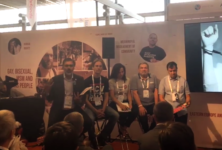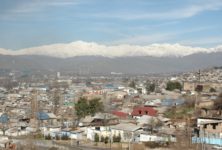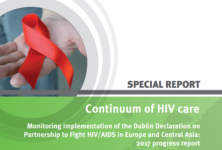Researchers at Boston Children’s Hospital have developed a technology to quickly generate mouse models for testing and tweaking potential HIV vaccines. Such models could speed up the quest for the AIDS field’s “holy grail”– a vaccine that elicits broadly neutralizing antibodies able to fight any mutant HIV strain. Findings are published September 8 in the journal Cell.
HIV frequently changes its coat protein, eluding the human immune system’s efforts to neutralize it. While a handful of HIV-infected people can produce broadly neutralizing HIV antibodies, this usually results from years of exposure to the virus, allowing the immune system to modify antibodies to catch up with viral changes. People first make precursor antibodies, which then mature via mutation and natural selection, becoming more protective over time.
“This is a long-term process, involving many intermediate antibodies, making it very challenging to design HIV vaccines to protect uninfected individuals,” says Frederick Alt, PhD, director of the Program in Cellular and Molecular Medicine at Boston Children’ Hospital, co-senior author on the paper with John Mascola, MD, director of the NIAID’s Vaccine Research Center (VRC).
“Only a small fraction of patients are able to develop broadly neutralizing antibodies, and by the time they do, the virus has already integrated into the genomes of the patient’s T-cells,” says Ming Tian, PhD, co-first author on the paper with Cheng Cheng, Xuejun Chen and Hongying Duan, of the NIAID’s Vaccine Research Center (VRC), and Hwei-Ling Cheng of the Alt Lab.
So the researchers began with the question: How do broadly neutralizing antibodies naturally arise in HIV infected individuals? And how can we recapitulate that process to create an effective vaccine?
“To facilitate this effort, we wanted to design a new type of humanized mouse model that would be more physiological and also allow us to very quickly test new vaccination strategies,” said Alt.
Building a diverse immune repertoire
The Boston Children’s team began with the basic components of the known human antibody response to HIV. Antibody genes are assembled from building blocks known as V, D and J segments. Through various V-D-J combinations, our B lymphocytes are able to produce enormous numbers of different antibodies, enough that almost any invader can be recognized. After a B cell recognizes a pathogen, it further mutates the V-D-J sequence, often in successive steps, enabling its progeny B cells to produce even stronger antibodies.
Prior work had elucidated the structure of broadly neutralizing antibodies against HIV and deduced the V-D-J combinations that constituted their precursors. The team inserted the corresponding DNA into mouse embryonic stem cells.
Using approaches derived from prior work by the Alt Lab, the researchers then used the modified embryonic stem cells to rapidly generate mice whose B cells could assemble a highly diverse set of HIV antibody precursors, using the human precursor broadly neutralizing antibody “V” segment with various D or J segments.
An iterative process
The VRC group, with collaborators at the Duke Human Vaccine Institute, the Scripps Research Institute, the Fred Hutchinson Cancer Research Institute and other centers, then sequentially exposed the Alt Lab’s test mice to a series of specially designed HIV antigens. While the mice began by making immature “ancestor” antibodies, this sequential vaccination approach “taught” their B cells to produce ever more diverse and effective humanized antibodies that eventually were able to neutralize some HIV viral strains.
“Rather than go through generations of mouse breeding to make models, our approach allows us to quickly delete and replace genomic elements to create changes in B cells,” explains Alt. “Thus, we can rapidly re-program this mouse model with the intermediate antibody genes selected from the first successful immunizations, and expose them to new antigens. Over time, we hope this process will lead to the generation of broadly neutralizing HIV antibodies.”
As the engineered antigens engaged the system, upping the ante each time, the researchers could observe the antibodies acquiring mutations.
“You move the B cells in a direction and find out what works and the potential hangups,” says Alt. “You then work to figure out how to next adapt the mouse model and the immunogens to eventually get to a broadly neutralizing antibody stage.”
There’s still a long way to go, but Alt believes the technology could hasten the search for a truly effective HIV vaccine, as well as vaccines against other viruses. It may also allow researchers to generate highly specific therapeutic antibodies. “We’re hoping it will be broadly useful,” Alt says.
###
The study was supported by the National Institutes of Health and the National Institute of Allergy and Infectious Diseases (R01AI077595, AI020047, P01 AI094419 U19 AI109632); the NIH Center for HIV/AIDS Vaccine Immunology and Immunogen Discovery (CHAVI-ID) (AI100645, 5UM1AI100645, 1UM1 AI100663); the International AIDS Vaccine Initiative Neutralizing Antibody Consortium and Center; CAVD funding for the IAVI NAC Center; the Ragon Institute of MGH, MIT and Harvard; the VRC; and the Howard Hughes Medical Institute.
Boston Children’s Hospital is home to the world’s largest research enterprise based at a pediatric medical center, where its discoveries have benefited both children and adults since 1869. More than 1,100 scientists, including seven members of the National Academy of Sciences, 11 members of the Institute of Medicine and 10 members of the Howard Hughes Medical Institute comprise Boston Children’s research community. Founded as a 20-bed hospital for children, Boston Children’s today is a 404-bed comprehensive center for pediatric and adolescent health care. Boston Children’s is also the primary pediatric teaching affiliate of Harvard Medical School. For more, visit our Vector and Thriving blogs and follow us on our social media channels: @BostonChildrens, @BCH_Innovation, Facebook and YouTube.
See also:
- TSRI and IAVI researchers harness antibody evolution on the path to an AIDS vaccine
- New vaccination strategies coach immune system to make HIV-neutralizing antibodies


 ПОИСК ПО САЙТУ
ПОИСК ПО САЙТУ  поиск по ресурсному центру
поиск по ресурсному центру 


